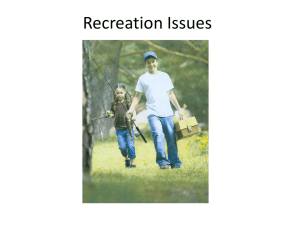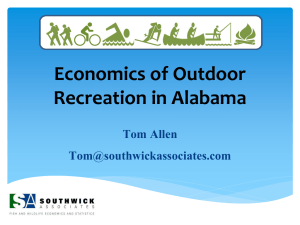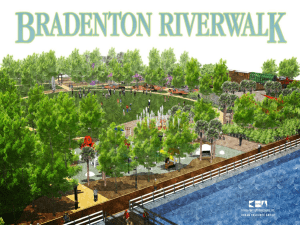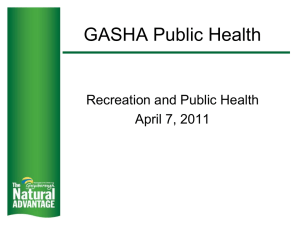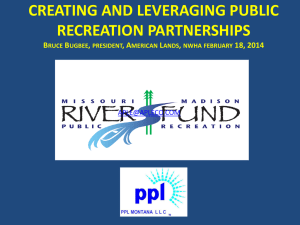Trends in Outdoor Recreation
advertisement
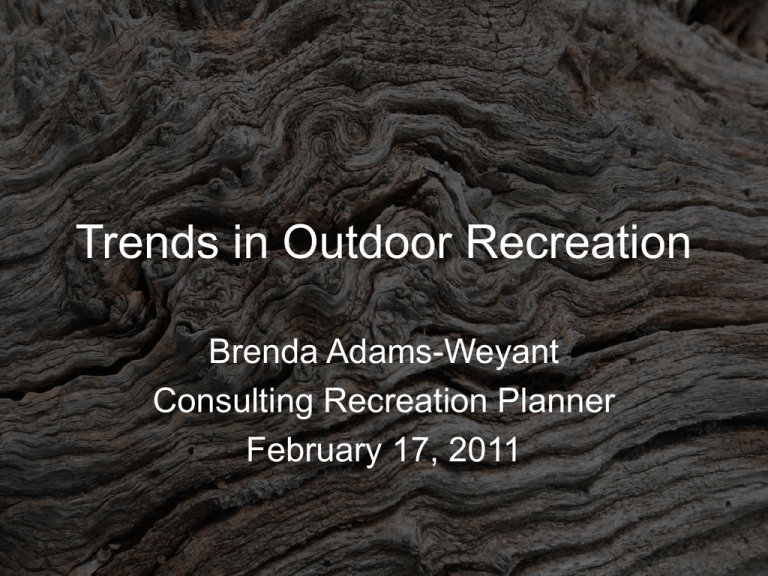
Trends in Outdoor Recreation Brenda Adams-Weyant Consulting Recreation Planner February 17, 2011 How are trends useful? • What is trend data? • Helps you decide how to prioritize investments in your recreation program. • Prepares you for requests for new recreational facilities. • Keeps you relevant to society. 2010 Outdoor Recreation Participation Report • Produced by the Outdoor Foundation since 2007 • Measures participation in outdoor recreation of Americans ages 6 and older • Surveys track 40 recreation activities. • Variety of reports available at: http://www.outdoorindustry.org/research.php 2010 Outdoor Recreation Participation Report • Nearly 50% of Americans ages six and older participated in outdoor recreation in 2009. That’s a slight increase from 2008 and equates to a total of 137.8 million Americans. • The gateway activities — fishing, running, camping, bicycling and hiking— are popular, accessible and often lead to participation in other outdoor activities. 2010 Outdoor Recreation Participation Report • 42% of outdoor participants said the economy impacted how often they participated in outdoor activities in 2009. • 62% of outdoor participants travel one hour or less to participate in outdoor recreation. • The participation rate in outdoor activities of Americans with walking routes near their home is 20% higher than those without, and the participation rate of those with nearby biking routes is nearly 25% higher than those without. 2010 Outdoor Recreation Participation Report • This study continues to track an overall downward slide in outdoor recreation participation among 6 to 12 year olds. – 2009 - 62% – 2008 - 64% – 2006 - 78% • A lack of time and interest keeps youth from getting outdoors more. 2010 Outdoor Recreation Participation Report • For youth ages 6 to 17, “fun” is the most common motivation for participating in outdoor activities. Discovery and exploration are common motivators. • Most youth are introduced to outdoor activities by parents, friends, family and relatives. • Decreases in outdoor recreation among youth may mean shrinking numbers of outdoor enthusiasts for future generations. • Helpful resource: Children & Nature Network http://www.childrenandnature.org/ 2010 Outdoor Recreation Participation Report • Outdoor recreation participants are more likely to support land conservation. • A larger percentage of outdoor participants believes that developing local parks and hiking and walking trails is important. • Outdoor recreation participants are more likely to have volunteered and donated to support environmental and conservation efforts. Trends in Wildlife Related Recreation • Trends between 1996 and 2006 • Source: US Fish and Wildlife Service, National Survey of Fishing, Hunting and Wildlifeassociated Recreation • Conducted every 5 years since 1955 • National and state-level reports available at: http://www.census.gov/prod/www/abs/fishing.html Nationwide Participation Trends •Fishing -15% •Hunting: -11% •Wildlife Watching (away from home): 13% Are land managers with traditionally large hunting and fishing programs adapting to the changing times? Will they remain relevant to society? National Survey on Recreation and the Environment (NSRE) • NSRE represents the continuation of the ongoing National Recreation Survey series that began in 1960. • Focuses on outdoor recreation participation and personal demographics. • Surveys people 16 years and older in the United States. • Surveys track more than 80 recreation activities. • More than half the US states use NSRE data during their SCORP development. • Reports and data at: http://www.srs.fs.usda.gov/trends/index.html Recent Trends in Nature-based Recreation, 1999-2008 • Nearly 60% of nature based recreation occurs in forested settings. • The fastest growing activities: View/photograph flowers, etc 78% View/photograph natural scenery 61% Driving off road 56% View/photograph other wildlife 47% View/photograph birds 38% Kayaking 29% Visiting water (other than ocean beach) 28% Backpacking 24% Visiting nature centers 23% (NSRE data, 2009) Recent Trends in Nature-based Recreation, 1999-2008 • Strongest declining activities: Downhill skiing -16% Picnicking -17% Canoeing -18% Migratory bird hunting -19% Day hiking -21% Snowmobiling -27% Mountain biking -33% Snowshoeing -37% (NSRE data, 2009) Reasons why kids do not spend more time outside (NSRE) Reason Interested in music, art, reading, etc. Male % Female Total % % 50.6 66.7 58.3 38.5 57.4 47.5 51.0 39.9 45.7 More involved in indoor sports 34.6 42.7 38.5 Time at mall shopping hanging out 25.3 29.8 27.4 20.4 32.1 26.0 Don't have transportation 15.0 25.3 20.0 Don't have anyone to play outdoors with 16.2 20.6 18.3 It is not safe to play or do sports outside 18.1 10.1 14.2 Injured or developed health problem 10.3 5.0 7.8 Interested in Internet, text messaging Interested in video games, DVDs, and TV Neighborhood does not have good access Common themes • Hunting and fishing declining • Need to get kids outdoors to ensure a future conservation constituency • Decline in snow-dependent recreational activities • Obesity epidemic is raising awareness of the value of public lands. The health care industry is becoming a stronger partner with land managers. Conclusion Ultimately, the fate of biodiversity and intact ecosystems may depend less on rates of habitat loss or invasive species, than on public perception of whether conservation should be supported at all. Zaradic, Pergam, and Kareiva 2009 Additional Resources National Association of Recreation Resource Planners: www.narrp.org Outdoor Foundation: http://www.outdoorindustry.org/research.php US Fish and Wildlife Service: http://www.census.gov/prod/www/abs/fishing.html US Forest Service (NSRE): http://www.srs.fs.usda.gov/trends/index.html University of Georgia: http://warnell.forestry.uga.edu/nrrt/nsre/IrisReports.html Brenda Adams-Weyant Consulting Recreation Planner brendaaw@verizon.net
